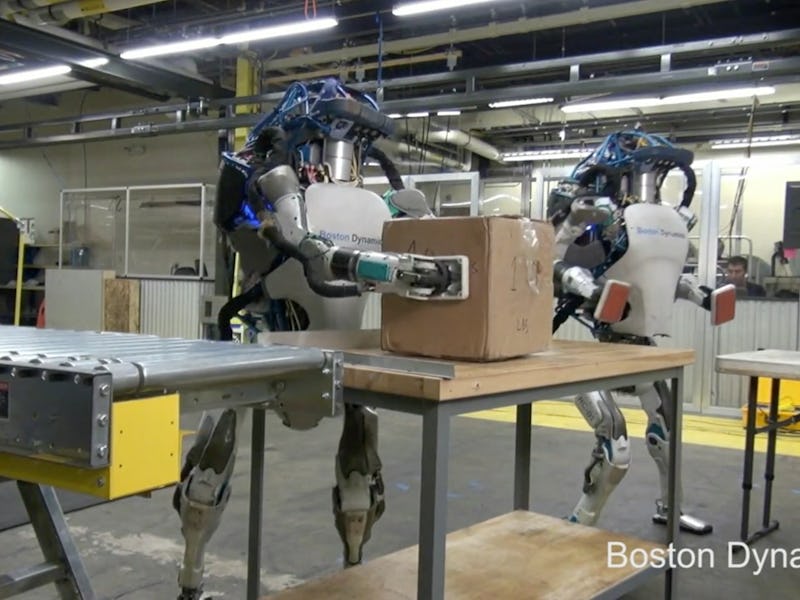Robot Coworkers Are Coming, and They're Going to Really Mess With Your Head
Robot colleagues can make our lives easier, but only if we can avoid resenting them.

The robotics community likes to say that we’re at an inflection point, something akin to software’s position in the 1980s. In 1984, around eight percent of households had a computer, according to US Census data, a percentage that grew to more than 23 percent by the early 1990s. That’s roughly two million households buying a new computer each year.
This is an adapted version of our weekly Strategy newsletter, which offers reporting and insights about your career, life, and finances. Sign up for free here.
Similar projections exist for the adoption of household and workplace robotics. About 4 million robots were sold in 2015, according to data from Loup Ventures, the vast majority of which were vacuum cleaners. That number is expected to soar to 23 million by 2025. By then, either robots or some other form of automation will be completing roughly 52 percent of tasks worldwide, according to a recent projection from the World Economic Forum.
There are a few factors at play in this acceleration. Each week, the field overcomes new hurdles, and as 5G networks drastically expand network capacity over the next two years, that pace of progress will get even faster. If you don’t have robot colleagues already, it’s only a matter of time.
It should come as some relief to hear that research is already underway to see how robot growth is going to affect your workday.
The projected migration of tasks from human to machines, according to the WEF's data.
Robots Don’t Need to Take Jobs to Take a Toll on Workers
It’s obviously awful to be automated out of a job. But what if the robots you work with are simply colleagues? That’s the question underlying a study from a fascinating group of researchers at Cornell whose expertise spreads across engineering, robotics, and behavioral economics. In the study, published last month, the researchers tried to tease out the emotional impact of working alongside a robot with an identical job. The workplace, after all, is a competitive place — what happens when you make workers compete with robots who, obviously, don’t mess up or get tired? It turns out, they don’t like it.
“People thought they were worse at the job when the robot was there,” Guy Hoffman, a professor of mechanical and aerospace engineering who specializes in robot-human interaction, tells Inverse. “To me, this raises the question of whether there’s this downside to highly productive robots working alongside people.”
To test for this effect, Hoffman, along with lead author Alap Kshirsagar, co-author Ori Heffetz, and two graduate students, pitted humans and robots against one another in a pretty tedious task, identifying G’s out of a string of letters. The better the human or the robot did, the greater their odds of winning a prize.
"“When the robot was faster, they knew their overall chances to win the prize are lower, and they tried less hard."
Throughout the challenge, the players were able to see their odds of winning, which allowed the researchers to assess whether working with a fast or slow robot had a different effect on the human participants. What they found leaves room for concern: The better the robot was doing, the less the human participants tried.
People, including John Oliver, are starting to pay more attention to automation and its possible downstream effects.
How Loss Aversion Comes Into Play
Ori Heffetz, an economics professor at Cornell and The Hebrew University of Jerusalem, explains that this is likely due to loss aversion, a common theory in behavioral economics which holds that people tend to prioritize avoiding losses over pursuing gains. Loss aversion, he said in an email, explains why people tend to slack off more when competing against a robot they thought would win anyway.
“People evaluate their outcomes not only in absolute terms, but also relative to a reference point,” Heffetz explained in an email. “Our task-competitors seemed to evaluate winning the prize relative to how much they expected to win it; when the robot was slower, they expected to win the prize more and worked harder to avoid disappointment. When the robot was faster, they knew their overall chances to win the prize are lower, and they tried less hard.”
Loss aversion is powerful. It explains why we’re too hesitant to bet our chips in poker, and why we’ll sometimes slack off when a goal seems unrealistic to us. In terms of financial behavior, it also explains why most people who invest tend to do the opposite of what they’re supposed to do, and buy assets when they’re high and sell them when they’re low. This effect is said to be about twice as psychologically powerful as the effect of equivalent gains, according to a famous 1992 paper by the Nobel-winning economist Daniel Kahneman.
As to how we can triumph over loss aversion when robots are in the picture? More research needs to be done. And after all, spotting the “G” in a long strings of letters isn’t the same as doing a job where you can (at least hopefully) gain some satisfaction from seeing tasks being accomplished.
Heffetz says the next step is to continue studying how and where humans form reference points for when they feel like they’re winning and losing. A robot, after all, is obviously not a fair reference point to assess human ability. If we can crack the code to that particular question, then we might be able to crack the code for how to make robot-human collaboration a win-win for everyone.